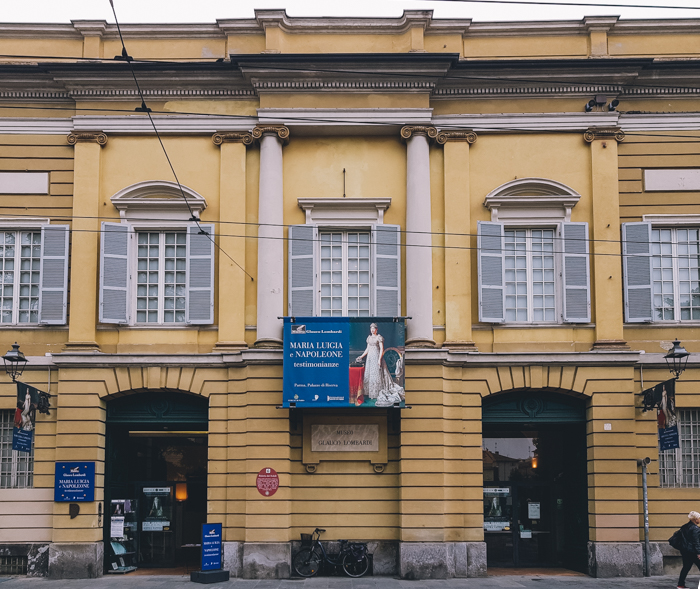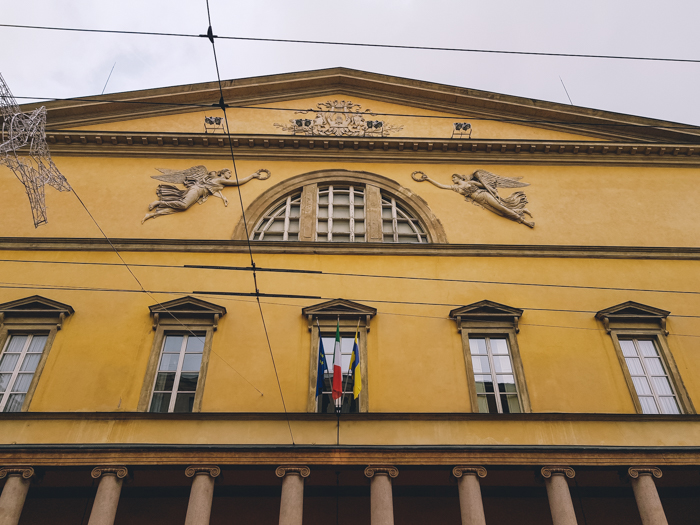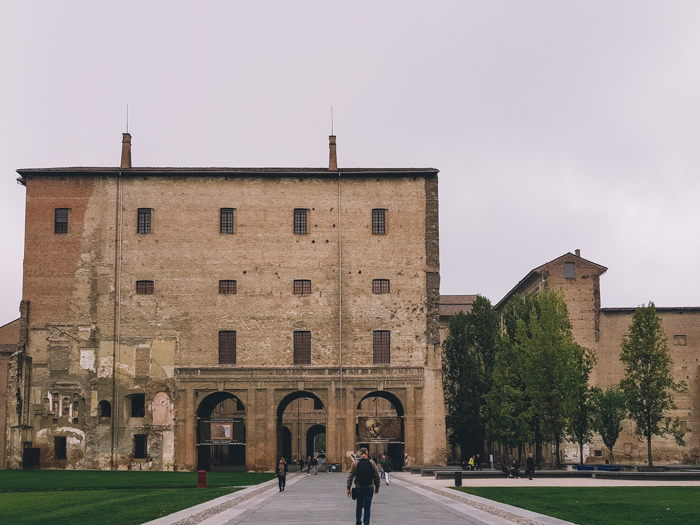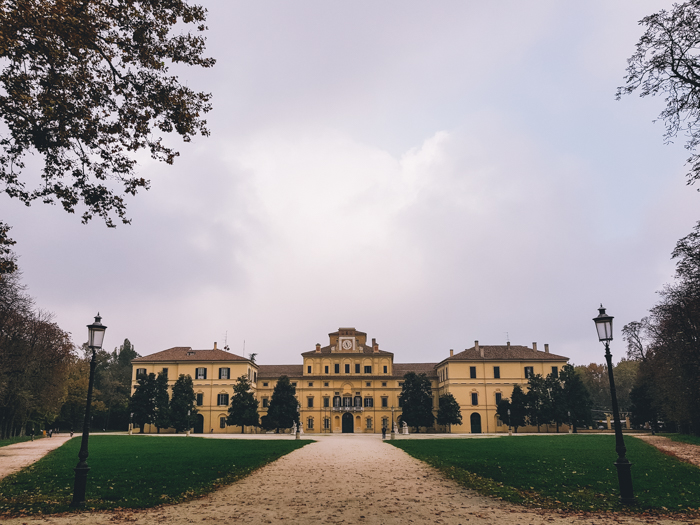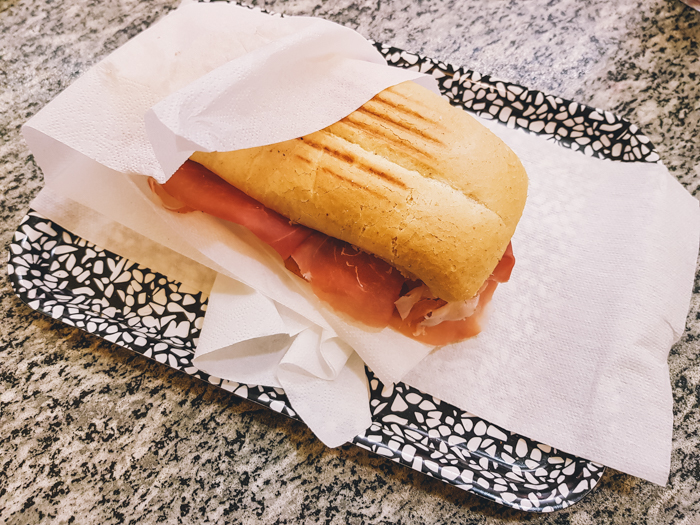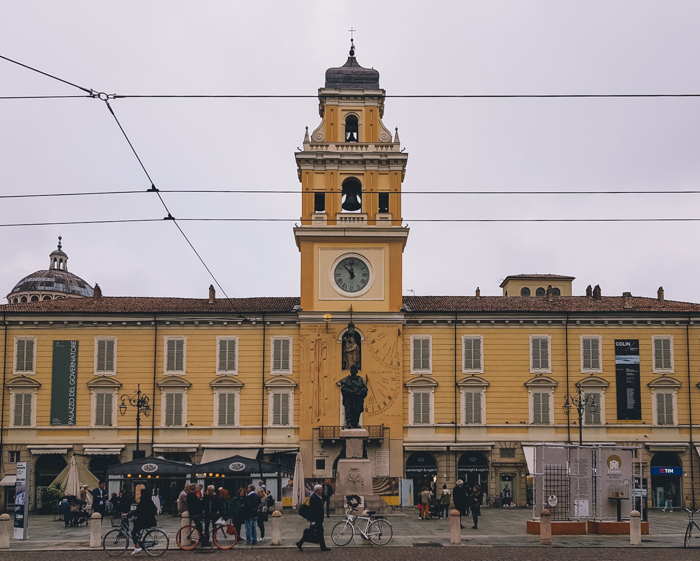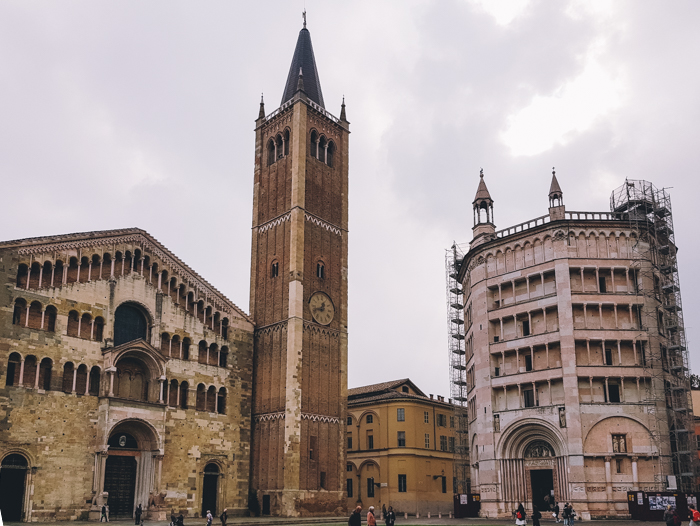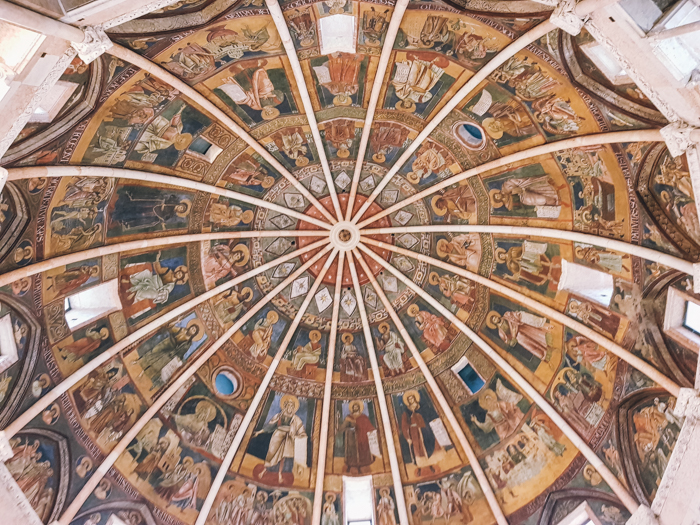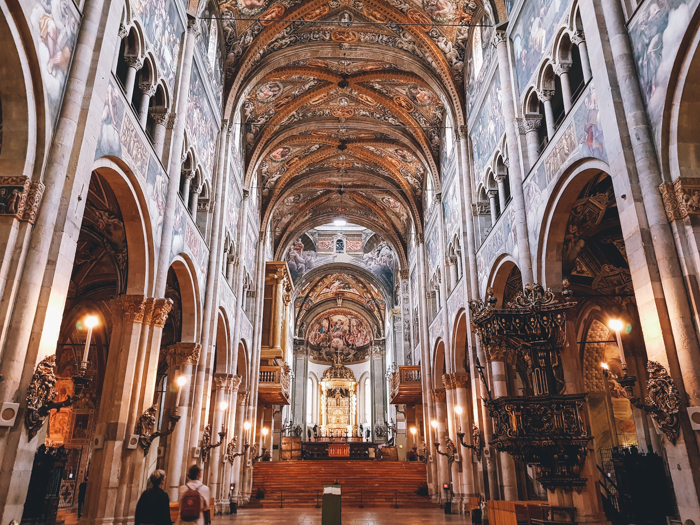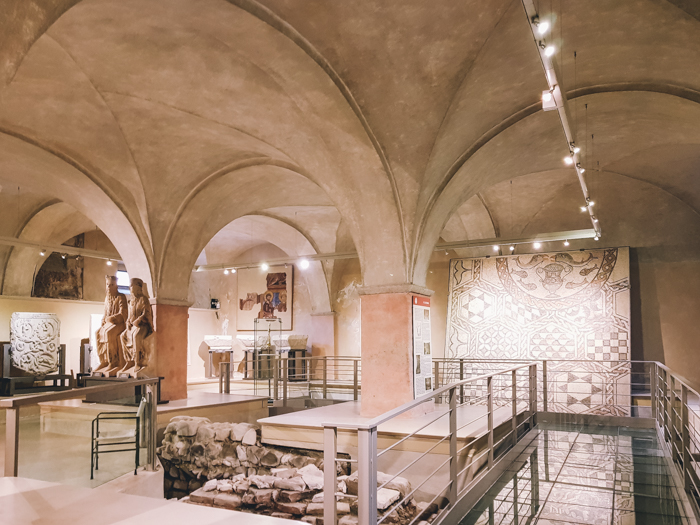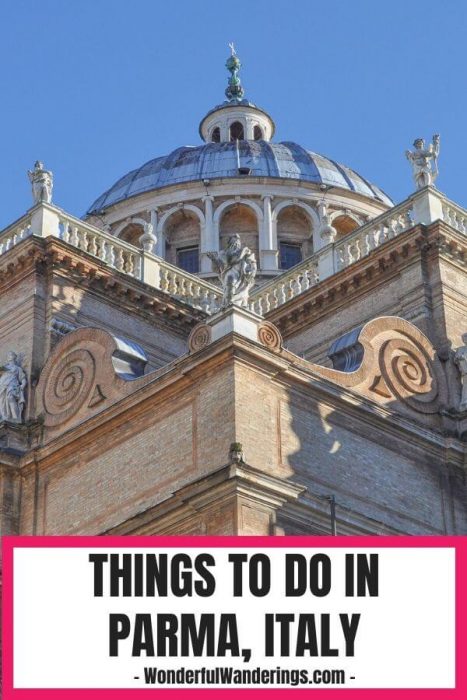The colorful town of Parma in the Emilia Romagna region of Italy is known for its music, medieval architecture, and impressive art. Yet, it’s even more famous for its traditions and food – the two specialties being Parmigiano Reggiano (cheese) and Prosciutto di Parma (Parma ham), but the Parmense claim stuffed pasta variations like Tortelli d’erbetta and Anolini in brodo originated with them too.
In between courses, there are plenty of things to do in Parma. Let’s have a look.
Contents
- Things to do in Parma Italy
- 1. Visit the Museo Glauco Lombardi
- 2. Attend a show at the Teatro Regio di Parma or the Teatro Farnese
- 3. Check out the Palazzo della Pilotta
- 4. Visit the National Gallery
- 5. Walk around the Parco Ducale
- 6. Have a look around the grounds of the University of Parma
- 7. Have a panini for lunch
- 8. Stroll over to the Piazza Garibaldi
- 9. Visit the Baptistry, the Duomo, and the Diocesan Museum
- 10. Have fun at the Casa del Suono
- How to get to Parma
- Where to stay in Parma
- Enjoy sightseeing in Parma
Things to do in Parma Italy
1. Visit the Museo Glauco Lombardi
Professor Glauco Lombardi, an Italian author and art historian, bought the Empress Marie-Louise’s belongings from the Savoy family, and he later established this museum in the Palazzo di Riserva.
Among the eclectic collection of art are the empress’ gowns, jewels, and furniture. You’ll see crockery, the embroidery she made and learn about her family and connections. The Glauco Lombardi Museum also displays cultural works from Parma. On display are paintings by Paulo Toschi, Giuseppi Molteni, and Giuseppe Drugman.
2. Attend a show at the Teatro Regio di Parma or the Teatro Farnese
Theatre lovers get to enjoy the sights of Parma’s two prominent playhouses – Teatro Regio di Parma and Teatro Farnese.
The Teatro Regio is a neoclassical opera house that might appear plain on the outside, but its splendid interior is worth mentioning. It was originally built in 1829, called the Ducal Theater, and renamed the Teatro Reale before the final change to its current name.
The foyer was built with four pairs of marble columns and a marble floor. The 1400-seated auditorium was constructed with granite columns forming an arcade that supports five imperial-style windows and decorations.
The Farnese Theatre is a Baroque-style playhouse built in the early 1600s. The auditorium was almost completely destroyed during World War II but was eventually restored to its original design. True to the Italian heritage-proud nature, you’ll see that some of the restructured parts were left bare so that the people can remember the extent of the damage caused.
It’s also the first theatre with a permanent proscenium arch and one of the few renaissance playhouses in existence. It was only used nine times – for ducal marriages and state visits. Today, it’s made of wood and plaster, and the painting technique gives it a marble look.
The massive building has 14 rows of seats, is five-tiered, and can hold up to 3000 people. The individual box seats are circular, covered in red velvet, and decorated with gold trimmings.
3. Check out the Palazzo della Pilotta
On the banks of the River Torrente Parma and about a five minutes walk from the Piazza Garibaldi, you can find the Palazzo della Pilotta. What was once the Farnese family’s home, which was badly damaged in World War II, is now a ducal palace and a courtyard.
Since the Palazzo della Pilotta has been rebuilt, the old building holds the Archeological Museum, a library, the Parma National Gallery, and the Farnese Theatre (which you learned more about above).
When entering the Palazzo della Pilotta grounds, you walk past statues along a brick walkway that used to connect the Viscontea Fortress to numerous other houses that the family occupied. The huge courtyard was once a ball court, but now you can appreciate stunning facades and plain stone buildings.
The National Archeological Museum
The second floor holds treasures that are related to Parma. While the first floor displays collections that include Roman, Egyptian, and Greek relics. Some of the treasures that you’ll see are ceramics, coins, sculptures, and glassware.
The Library
Still on the first floor, after you pass the archeology section, you’ll find The Biblioteca Palatina. It has three halls; the Marie Louise Hall, Dante Hall, and the Petitot Gallery. This small room’s antique books and rare manuscripts draw special attention to this visit.
4. Visit the National Gallery
You’ll notice the marble staircase at the National Gallery entrance. The art collections were moved by King Charles III of Spain in the early 1700s and then stolen by Napoleon during the French occupation.
Parma was fortunate to receive their valuables two years later. In the National Gallery, you’ll find a collection of Egyptian, Roman, Etruscan, and Greek relics dating from the middle ages to the 20th century.
Today, the National Gallery holds paintings such as the portrait of Erasmus of Rotterdam” by Hans Holbein, “Madonna and Child” by Anthony van Dyck, and the “Madonna della Scodella” by Correggio.
Besides the work of these art legends, you’ll see numerous artworks by Parmigianino, Fra Angelico, and El Greco (among others). The highlight of this excursion is the painting “La Scapigliata” by Leonardo da Vinci.
5. Walk around the Parco Ducale
Opposite the Palazzo della Pilotta is the largest park in the city that, covers over 200 m2 / 2152 sq ft. The Parco Ducale was originally built in the 16th century as formal gardens for Duke Ottavio Farnese. It’s no longer used as a palace but as government buildings.
Simply known as “The Garden,” the park is Parma’s most popular recreational space. It’s laid out with avenues lined with fruit trees and plants with complementing sculptures when it was extended in the 18th century.
More prominent features of the French-styled Park include ruins of the Arcadia temple and the Fountain of Parma River that’s placed in the middle of the lake. Marie-Louise changed the park to a more English look when she opened it to the public.
The modern facilities of the Parco Ducale also include sports tracks and a café with outdoor tables.
6. Have a look around the grounds of the University of Parma
When visiting Parma, you’d be pleasantly surprised to find botanical gardens at a university on the Viale Martiri della Liberta. The grounds were created in 1770, but the glasshouses were built two decades later. The large grounds (about 11000 m2 / 118400 sq ft) have over 2000 species, and among the freakiest are the insect-eating plants.
The purpose of the garden is to protect the plant life for the future and even those that are not in their natural habitat. You’ll find numerous plant types, such as Aquatic plants, Lemna plants, and various tree species.
When exploring the greenhouses, you’ll also get a chance to see tropical plants and fruits.
7. Have a panini for lunch
This is not an ordinary ham and cheese sandwich. Panini originated in sandwich shops in the 1960s when workers wanted quick lunch choices. There are variations of the bread roll, such as ciabatta, focaccia, and baguettes. The bread is filled with mouthwatering ingredients and pressed on a grill.
Classic fillings for this scrumptious meal vary from the traditional prosciutto di parma and fontina cheese to bresaola, goat cheese, and tomato. But like everything else, the Panini has also evolved, as popular filling choices for this sandwich range from fig and ham to chicken and pesto.
8. Stroll over to the Piazza Garibaldi
Located on a busy town square in the heart of the town of Parma is a large palace called Piazza Garibaldi. It’s no wonder the piazza is named after Giuseppe Garibaldi, as he was instrumental in the unification of Italy.
On one side of this Parma sightseeing hotspot lies the Palazzo del Governatore, and the rest of the square is surrounded by other classic buildings worth mentioning, such as the Roman Catholic church of Saint Pietro and the Palazzo Fainardi building.
Just behind the bronzed sculpture is the Governor’s Palace which was first created in the 13th – century. However, it needed restoration in the 1600s when the clock tower collapsed.
Today, the building has a central yellow-plastered bell tower. The original bell dates back to the 1400s but was replaced in 1998.
The Baroque-styled building has a niche that displays a statue of the Crowned Virgin Mary, and above her are paintings of an astronomical clock. The 17th-century sundial is pretty accurate in telling the time and date.
The ground floor has various little shops where you can relax and people-watch. Once you enter the government building, you’ll find contemporary and modern art, including international exhibitions. The small municipal office’s excellent architecture is a place for cultural events.
9. Visit the Baptistry, the Duomo, and the Diocesan Museum
At the heart of the city lies the Piazza del Duomo. It’s home to monuments such as the Baptistery, The Parma Cathedral, and the Diocesan.
The Baptistery
The 12th-century Baptistery is a mix of Romanesque and Gothic styles. Its octagon shape and sparkling rose-colored marble was designed and built by Benedetto Antelami.
The Battistero di Parma’s magnificent domed ceiling is covered with paintings of saints and angels. Besides the frescoes, the lower part holds sculptures showing the life of Christ, the months and seasons, and the Zodiac signs.
The Baptistry is dedicated to the Blessed Virgin Mary. In the northern entrance of the Baptistery, you’ll meet sculptures of Archangels Raphael and Michael and the Queen of Sheba.
The Duomo
Next to the Baptistery is the Roman Catholic Parma Cathedral, known as Duomo di Parma. But before you enter, you’ll notice the 63m / 206 ft Gothic campanile standing beside it. The Parma Cathedral was heavily damaged in a 12th-century earthquake, and the remains of the original building were kept in some parts of the church, while the construction of the Gothic belfry began in 1284 and took a decade to complete.
The interior of the Parma Cathedral has a nave and columns dividing the church into two aisles and is covered with paintings of scenes from the bible. The dome is decorated with the 16th-century fresco “The Assumption of the Blessed Virgin Mary,” which shows her ascending to heaven.
You’ll even get to see the underlying crypt with early Christian mosaic floors, breathtaking pillars, and the tomb of the mathematician Biagio Pelacani.
The Diocesan Museum
This small museum is on the eastern side and lower-ground level of Bishop’s Palace. The exhibition shows the spread of Christianity chronologically, from Roman times to medieval times.
Besides Christian artifacts, you can admire the Romanesque walls, stuccoes, and medieval ceramics. The original “The Cathedral’s Angel” is kept in the Museum, while the bell tower holds a replica –representing Archangel Raphael.
10. Have fun at the Casa del Suono
This modern museum is a haven for audiophiles. The House of Sound is divided into sections centered around the evolution of early-years music technology to modern devices. It’s situated in a 17th-century former church (Chiesa di Santa Elisabetta) and built with beautiful arches and painted ceilings.
You’ll discover 1970s tape recorders, the evolution of the phonograph to the gramophone, and from radio to the tape recorder. Learn about the journey of the CD to the iPod and see vintage broadcasting sound instruments like the jukebox.
The highlight of visiting this small museum is the high-tech sonic chandelier, including the sound benches and sound room.
How to get to Parma
The Parma train station lies within walking distance from all the main sites and is easy to get to from other cities in the region, like the regional capital of Bologna. Check Omio to get an overview of all possible train options as there’s more than one train company in Italy.
Where to stay in Parma
Budget: B&B Nabucco
This cheap and cheerful B&B is a short walk from the Parco Ducale and the train station. The rooms are clean and bright, with a private bathroom (complete with bidet), and you even have your own balcony. Air conditioning and free WiFi are provided, as is a delicious Italian breakfast.
View on Booking.com / Read reviews on TripAdvisor
Chain: Holiday Inn Express Parma
With Holiday Inn, there are never any nasty surprises! The rooms are spacious, clean, and comfy, with ensuite bathrooms and free WiFi. This great value hotel is situated just outside the city ring road, so it’s a little bit further out. But you’re just a five-minute drive away from many of the Parma activities listed above.
View on Booking.com / Read reviews on TripAdvisor
Luxury: B&B La Terrazza sul Duomo
Everything about this hotel screams decadence. Its best feature is the sun-trap terrace that literally overlooks the spectacular Parma Cathedral, which is right next door. A beautiful historic building full of character, paintings, dark wood furniture, and timber ceiling beams. This hotel is right in the middle of town, only a short walk from most of the city’s most famous sites.
View on Booking.com / Read reviews on TripAdvisor
Apartment: La Casa di Ortensia
This cute balcony apartment offers great value and is fully equipped with everything you need for a lovely stay when visiting Parma. It’s a little bit further out of town, situated about 1.6 km / 1 mile from Parma train station and about a 20-minute walk from the center.
Booking is a great tool for hotels, but I recommend using Airbnb for more apartment options, as it has a great selection.
Enjoy sightseeing in Parma
That’s some of the things to do in Parma in a day! Whether it’s incredibly tasty food such as prosciutto di parma or awe-inspiring cultural artifacts like the Piazza del Duomo you crave, you’ll find plenty of attractions in Parma, Italy, to indulge in.
PIN FOR LATER

